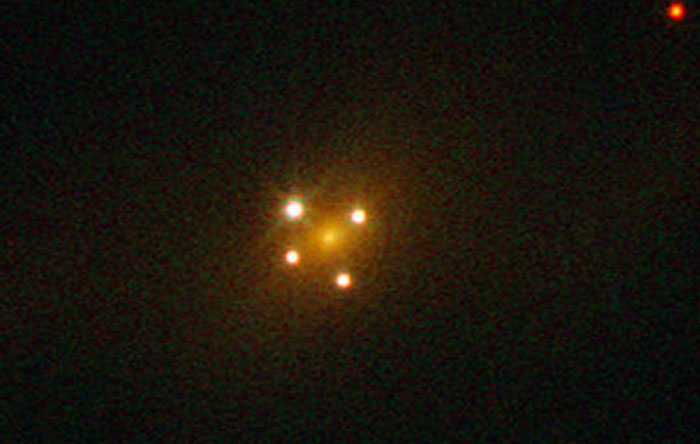.

The multiplied cross pattern of the quasar. Image: NASA/Hubble.
.
Astronomers based out of the University of Michigan have calculated the spin of a supermassive black hole a whopping ten billion light years away. The research was led by astrophysicist Mark Reynolds, and is slated for publication in the September issue of Astrophysical Journal Letters.
And though calculating the spin of black holes at the edge of the universe is an interesting pursuit on its own merits, Reynolds’ research has all kinds of repercussions for the astronomy as a whole.
“How do galaxies form? How does this relate to the black holes at the centers?” he said in a phone interview. “This information is encoded in the spin of the black hole. This is one of the biggest issues in astronomy.”
The black hole is powering an ultra-luminous quasar, or at least it was billions of years ago. The quasar is popularly known as the Einstein Cross, due to gravitational lensing effect that multiplies its image fourfold into a cross-like pattern.
“It’s the most distant object for which the spin has been directly measured,” Reynolds said. “The universe is about 13.7 billion years old, so this is going significantly back towards when the epoch of furious galaxy formation was happening.”
The multiplied cross pattern of the quasar. Image: NASA/Hubble.
It’s sort of the universe’s riff on drunken double-vision (or in the case of this quasar, quadruple-vision). Einstein’s name was tacked on because he was among the first to recognize that if gravity could bend light, it could likely act as an intergalactic magnifying glass lens.
In this case, the lens creating the distorted closeup of the Einstein Cross is a massive spiral galaxy about 500 million light years distant, conveniently positioned between Earth and the quasar.
“If you can imagine that these objects were exactly aligned, you won’t get multiple images, you’ll just get a ring,” Reynolds said of the distinctive cross pattern. “What happened here is that you are just a little misaligned, so then you get multiple images.”
“The key point here is that the lensing galaxy and the galaxy in the background have to be very, very close to being perfectly aligned, so the angles of deflections are very small,” he continued. “That’s when you see these strong gravitational lensing effects."
With the help of this galactic microscope, Reynolds studied 26 observations captured by NASA’s Chandra X-ray Observatory over a 13 year period. The team was looking for signs of X-rays bouncing around the black hole’s innermost accretion disk, which provide telltale information about the warped spacetime surrounding the event horizon.
“Black holes don’t emit any radiation themselves, so you basically need a light source falling into the black hole,” Reynolds told me. “The gases that they’re accreting are a source of very, very high energy radiation that gets created in the inner regions of the accretion disk, due to the high temperatures.”
“This source of radiation basically shoots X-rays down into the accretion disk, which kick out electrons from the gas in the disk,” he said. “Iron is the most important element in the disk. When we see emission from iron, and from the other characteristic features from the inner accretion disk, we can use that to constrain the gravitationally distorted spacetime around the black hole.”
Since Reynolds’ team already knew the mass of the black hole—a whopping one billion Suns—they could calculate the spin from there. And what a spin it is! Turns out that the black hole powering the Einstein Cross is whizzing away with abandon.
“What we’ve been able to show for this black hole, which is the first time that we’ve had a direct measurement at such a large distance, is that it it is rotating rapidly,” said Reynolds. “But we only have this one sample at a very high redshift now, so of course what we want to do now is study more of these systems.”
“There’s of course interesting science to be done by digging deeper into this system, but ideally we’d like to have a number of black holes at different redshifts,” he said. “Currently there are over 20 strongly lensed quasars with redshifts of 1 or greater, so our plan is to start attacking these guys over the next few years. This will be a step forward, and will help us form theories and predictions for what we expect to see with the next generation of facilities coming online in the 2020s, like JWST and ATHENA.”
Quelle: Motherboard
4791 Views
